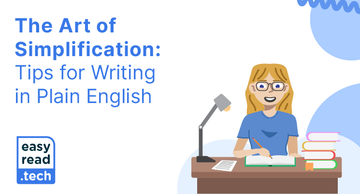The Art of Simplification: Principles for Writing in Plain English

Plain English is a powerful tool of communication that simplifies information and presents it in a concise and well-organised format that is appropriate to the intended audience. Plain Language cuts through all the jargon and unnecessary fluff, instead conveying key messages in a straightforward manner.
Plain English promotes accessible communication and can be applicable and beneficial for everyone!
Here are seven principles to help you improve your Plain English writing skills:
1. Consider your target audience
Like with any written text, it is essential to consider your text’s intended audience. Some factors that will shape your final document include your audience’s:
- education and literacy level
- familiarity with the topic
- age
- cultural background.
2. Separate the ‘nice-to-know’ from the ‘need-to-know’
Think about what you want your reader to gain or learn after reading the text and leave out anything that does not contribute to the key messages you want to convey.
It is also important to consider any assumed knowledge and whether this needs to be included in the document for the reader to comprehend it.
3. Stick to one idea per paragraph
By limiting your paragraph to include one main idea or theme, your text will be easy to follow and will adopt a simple and logical structure.
You can also organise your paragraphs efficiently by opening with a topic sentence that introduces the paragraph’s main idea and concluding with a sentence that concludes the idea and transitions onto a new one.
4. Write for your reader
This principle is all about making the text personal, as if the reader is being explained the information in-person. This can be done by using pronouns like ‘we’ and ‘you’ to address the reader directly. This will allow the text to have a conversational tone, and as such, help the reader to feel connected to the text and the information within it.

5. Use everyday language and define technical terms
Using direct language and simple, everyday words will make your text easy to understand for a wider population. You should only use highly technical or specialised terms if you know your readers will understand their meaning, or it is necessary, and they can be defined. Any abbreviations or acronyms should also be explained in their first use.

6. White space is thinking space
While having lots of white space on a page may look inefficient, having ample white space is important for legibility, as it provides room for your reader to process information incrementally. Use wide margins that leave plenty of space on your page and increased line spacing and paragraph spacing that will leave your document looking clean rather than crowded and dense.
7. Include easy-to-follow design features
Features like headings, lists and tables can help to break up text and enhance the overall legibility of your document. Simple text formatting features like italics and bold can help emphasise key concepts and terms. However, you should be careful not to overdo it to dilute its impact and make the document visually confusing.


Which one do you think is more appealing?
8. Proof your work
Ensure your text is proofread and tested, preferably by someone within your target audience, so they can verify whether the text is clear and understandable.
Tools like the Flesch‐Kincaid readability test and the Hemingway Editor app may be helpful but are limited in their ability to judge the complexity of the ideas presented in the text, the effectiveness of the structure of the text or the layout of the document itself. Therefore, a second (or even a third) pair of eyes is the best way to ensure your document is ready for release.
Promoting Plain English is a valuable step towards accessible communication, and Easyread.tech is available to help transform your documents into Plain Language today. Let's work towards a more accessible and inclusive society, one word at a time!
